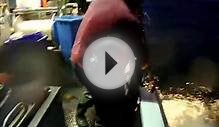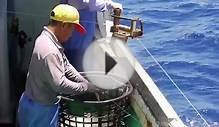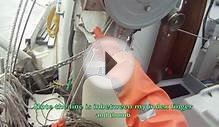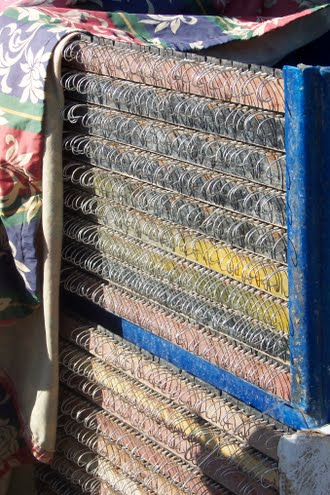
Tuna longliningDrawing of tuna longlines fishing operation (from Tuna Atlas).
 OverviewLonglining is a passive variety of fishing method using lines with baited hooks as fishing gear. Types EnvironmentLongline are employed primarily to capture huge and in exotic waters plus and, , in temperate waters.Fishing GearThe longline useful for tuna fishing consists of products (sometimes generally "baskets"), each of which consists of a principal horizontal range about 250 to 800 m long with 4 to 15 branch-lines, each with a wire frontrunner and a hook. The level where in actuality the hooks tend to be set-in water line is an essential factor, this depth in which the longline is satisfied can be regulated mainly by modifying the periods of primary range between float outlines and partially by modifying the size of float-line and/or the speed of shooting, to a lesser extent, by altering along the branch-lines.Vessel OverviewIndustrial tuna longliners usually are big vessel with size varying between 30 and 70 m. The basic requirements of a tuna longliner, professional type, tend to be: adequate rate to reach a long way away fishing grounds, adequate autonomy (fuel, liquid, accommodation of team, etc.), convenience of running into the high sea (occasionally really harsh seas at cold temperature), center for very efficient freezing storage space (to realize incredibly cold weather under 45°C) to keep the extremely respected tuna for months collectively, appropriate deck arrangement and gear, defense of staff from rough weather and sea problems, machineries for shooting and hauling up longlines rapidly and appropriate storage space facilities for maintaining the fishing gears and accessories. These huge specialised vessels can avoid their property ports for 10-24 months.Fishery manufacturing SystemsPossible exploitation types utilizing tuna longlining are: commercial and semi-industrial.Handling ModeIf the vessel's cruise is less than four weeks, the tuna can, in principle, be stocked straight in isolated fish hold. However, these days the large commercial tuna longline vessels used to stay at water for months (often to virtually a complete 12 months). Such circumstance, the catch has got to be frozen (in perfect problems for keeping top quality for the item). Therefore it is necessary to draw out bloodstream, pre-cool, freeze and install seafood in a shop at a temperature of -40°C to -60°C. It's very essential to freeze the seafood animal meat to such a reduced temperature so as to retain the high quality and color for the beef for an extremely long-period.Fishing EnvironmentTuna longlining is done in open oceans including within the high sea. The hooks seafood in sub-surface areas and also at depths of about 100 to 300 yards (maximum depths of 175 m for old-fashioned longlines and of 300 m for deep longlines).Fishing OperationsTuna longlining is...
2. Setting longlinesA typical ready contains 200 or higher "units/baskets" connected collectively, with a buoy at each connection, and a total around 3 000 hooks. Usually part outlines tend to be saved independently and connected to the main line while casting the range, each hook being baited prior to leaving the vessel's deck. The vessel steams at between 9.5 knots and 11.5 knots. The longline is settled from aft storage wells from the top deck through a series of PVC pipelines and a hydraulic line feeder, situated from the reduced deck amidships, for a price around 450 m per minute (27 km each hour). The depth associated with the mainline could be diverse mostly because of the length between that your buoys are attached to, as well as by switching the rate of this feeder and rate of this vessel. The price of which branchlines (snoods) and buoylines tend to be connected to the mainline, and then the space between snoods, is managed from the wheelhouse. Radio buoys are used for choosing the range in the beginning of the haul or in the function of a broken range. Between 2 500 and 3 000 hooks are set over a complete length of about 100 km, taking about five or six hours to complete each ready. About five staff users are required the setting. After the last radio buoy is scheduled, the staff retire for about four-hours prior to the start of hauling procedure. As a whole the beginning time for hauling the outlines depends upon how many baskets set.
OverviewLonglining is a passive variety of fishing method using lines with baited hooks as fishing gear. Types EnvironmentLongline are employed primarily to capture huge and in exotic waters plus and, , in temperate waters.Fishing GearThe longline useful for tuna fishing consists of products (sometimes generally "baskets"), each of which consists of a principal horizontal range about 250 to 800 m long with 4 to 15 branch-lines, each with a wire frontrunner and a hook. The level where in actuality the hooks tend to be set-in water line is an essential factor, this depth in which the longline is satisfied can be regulated mainly by modifying the periods of primary range between float outlines and partially by modifying the size of float-line and/or the speed of shooting, to a lesser extent, by altering along the branch-lines.Vessel OverviewIndustrial tuna longliners usually are big vessel with size varying between 30 and 70 m. The basic requirements of a tuna longliner, professional type, tend to be: adequate rate to reach a long way away fishing grounds, adequate autonomy (fuel, liquid, accommodation of team, etc.), convenience of running into the high sea (occasionally really harsh seas at cold temperature), center for very efficient freezing storage space (to realize incredibly cold weather under 45°C) to keep the extremely respected tuna for months collectively, appropriate deck arrangement and gear, defense of staff from rough weather and sea problems, machineries for shooting and hauling up longlines rapidly and appropriate storage space facilities for maintaining the fishing gears and accessories. These huge specialised vessels can avoid their property ports for 10-24 months.Fishery manufacturing SystemsPossible exploitation types utilizing tuna longlining are: commercial and semi-industrial.Handling ModeIf the vessel's cruise is less than four weeks, the tuna can, in principle, be stocked straight in isolated fish hold. However, these days the large commercial tuna longline vessels used to stay at water for months (often to virtually a complete 12 months). Such circumstance, the catch has got to be frozen (in perfect problems for keeping top quality for the item). Therefore it is necessary to draw out bloodstream, pre-cool, freeze and install seafood in a shop at a temperature of -40°C to -60°C. It's very essential to freeze the seafood animal meat to such a reduced temperature so as to retain the high quality and color for the beef for an extremely long-period.Fishing EnvironmentTuna longlining is done in open oceans including within the high sea. The hooks seafood in sub-surface areas and also at depths of about 100 to 300 yards (maximum depths of 175 m for old-fashioned longlines and of 300 m for deep longlines).Fishing OperationsTuna longlining is...
2. Setting longlinesA typical ready contains 200 or higher "units/baskets" connected collectively, with a buoy at each connection, and a total around 3 000 hooks. Usually part outlines tend to be saved independently and connected to the main line while casting the range, each hook being baited prior to leaving the vessel's deck. The vessel steams at between 9.5 knots and 11.5 knots. The longline is settled from aft storage wells from the top deck through a series of PVC pipelines and a hydraulic line feeder, situated from the reduced deck amidships, for a price around 450 m per minute (27 km each hour). The depth associated with the mainline could be diverse mostly because of the length between that your buoys are attached to, as well as by switching the rate of this feeder and rate of this vessel. The price of which branchlines (snoods) and buoylines tend to be connected to the mainline, and then the space between snoods, is managed from the wheelhouse. Radio buoys are used for choosing the range in the beginning of the haul or in the function of a broken range. Between 2 500 and 3 000 hooks are set over a complete length of about 100 km, taking about five or six hours to complete each ready. About five staff users are required the setting. After the last radio buoy is scheduled, the staff retire for about four-hours prior to the start of hauling procedure. As a whole the beginning time for hauling the outlines depends upon how many baskets set.
Source: www.fao.org
RELATED VIDEO

Long Line Fishing For Giant Bluefin Tuna

LONGLINE FISHING ENG 14Aug2013 WMV

Fishing Alaska Longline Danger

 Longline fishing is a commercial fishing technique. It uses a long line, called the main line, with baited hooks attached at intervals by means of branch lines called snoods (or gangions). A snood is a short length of line, attached to the main line using a clip or...
Longline fishing is a commercial fishing technique. It uses a long line, called the main line, with baited hooks attached at intervals by means of branch lines called snoods (or gangions). A snood is a short length of line, attached to the main line using a clip or...
 Fishing is the activity of trying to catch fish. Fish are normally caught in the wild. Techniques for catching fish include hand gathering, spearing, netting, angling and trapping.
Fishing is the activity of trying to catch fish. Fish are normally caught in the wild. Techniques for catching fish include hand gathering, spearing, netting, angling and trapping.







